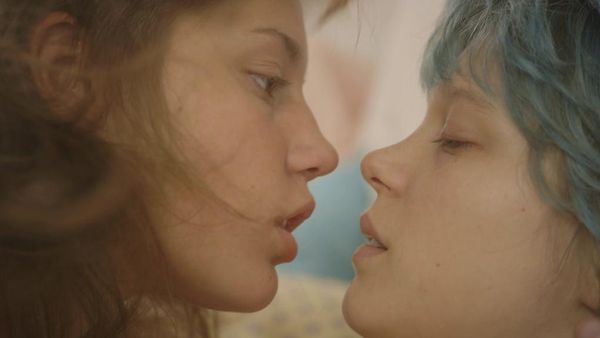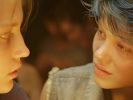Eye For Film >> Movies >> Blue Is The Warmest Colour (2013) Film Review
Blue Is The Warmest Colour
Reviewed by: Anne-Katrin Titze

Abdellatif Kechiche's vivid Blue Is The Warmest Color (La vie d'Adèle) is a commanding painting of passions, relationships and enlightenment.
His film, winner of the Palme d'Or at this year's Cannes Film Festival, is in stark contrast to many a Hollywood movie. Kechiche's teachers are at no time caricatures and frequently heroes. In Blue Is The Warmest Color, they ask questions about love at first sight representing a lack, "the essence of being human," or discuss if gravity can be a vice. You want to go to school and learn from them. Olivier Assayas's Something In The Air (2012) is another brilliant example of school shown as a place of teaching, not metaphor.

One of the first scenes set in a classroom is high-school-aged students reading out loud from playwright Pierre de Marivaux's La Vie de Marianne. The first two parts of the unfinished novel were published in 1731. Adèle, played by Adèle Exarchopoulos, loves the text. Her own life, the first two chapters of it, are the subject of Kechiche's film.
I show you what and how a person eats and drinks and you'll know more than words or decor could tell you, seems to be Kechiche's motto. Blue Is The Warmest Color, based on the 2010 French graphic novel by Julie Maroh, is the love story between teenage Adèle and art student Emma played by blue-eyed, blue-haired Léa Seydoux.
Their different social background is shown via food. Adèle's father (Aurélien Recoing) eats his "famous" spaghetti a bit like a grazing cow, the family watches TV during their meals, the mother (Catherine Salée) holds her fork precariously close to the tines, 15-year old Adèle drinks red wine just as her parents do, she has pasta sauce smeared all over her face, wants seconds, and licks her knife. In Zero Dark Thirty, Jessica Chastain ineffectively signalled that she was one of the boys with her knife licking.
Emma's family, artistic, liberal, and connected, serve the "best oysters" and langoustines when she brings over her new girlfriend for the first time. Emma forgot to tell her mother (Anne Loiret) and stepfather (Benoît Pilot) that the voracious Adèle likes to eat everything but seafood.
While physically the two women are a perfect match, their desires, world views, and set of friends tear them apart. Kechiche films several long and explicit love scenes, so intimately between two people, that you might feel like an intruder rather than a voyeur. You are watching what is none of your business. At the same time, the graphic scenes contain a theatricality that produces another level of distance. Kechiche stages someone's reality.
Mythological Tiresias, the blind seer and his experience of female pleasure compared to male is discussed at a garden party during which Emma's artist friends intimidate Adèle, who in the meantime has become a kindergarten teacher. Talk of Egon Schiele (badly and repeatedly misspelled in the subtitles at the press screening I attended) and Gustav Klimt make Adèle, who cooked the food, including daddy's pasta for the entire party, feel, just as out of place as she did during her parents' surprise celebration for her 18th birthday. She belongs to neither world, Kechiche shows, by having scenes find their inverted doubles. "It's funny. It's me and it isn't" says Adèle about Emma's first drawing of her.
We are kept chucked close to Adèle.
Flushed apple blossoms are in sudden bloom behind the schoolyard, the tree above the lover's bench shakes off its tired leaves. Time passes unannounced. The film leaps years forward and we have to catch up through hair color or living arrangements.
The camera registers every nuance on Exarchopoulos' expressive face, every stuck cookie crumb and every tear. The actress resembles at times a frightened Shelley Duvall from Kubrick's The Shining (1980), has Sandrine Bonnaire's vigor from Agnès Varda's Vagabond (1985), and is lost in her own thoughts in the manner of model Lindsey Wixson posing in Mulberry's 'Where The Wild Things Are' ads. The camera is so close to the actresses' faces, especially their mouths, that you start to worry about the garlic breath when Adèle decides to eat Gyros on a date.
Jean-Paul Sartre is "just like Bob Marley" for Adèle, whose name in the graphic novel was Clémentine. Kechiche changed it to the name of the actress to eliminate distance and because Adèle means 'justice' in Arabic.
Louise Brooks as Lulu in Pabst's Pandora's Box (1928) is screened at the fateful party that rings in the beginning of the end. Pregnant Lise (Mona Walravens) lets both hosts touch her belly. An action movie actor friend, who can speak Arabic, explains that this knowledge gives him great job opportunities to play terrorists in Hollywood.
The colour blue is placed everywhere - from Emma's hair to the denim jacket Adèle wears to match her love when they meet, to the ill-chosen blue dress at the gallery opening that seals chapter two. "I have infinite tenderness for you," can be a sentence sharper than a dagger and "two or three times," is the worst possible answer a liar can give when admitting a betrayal.
Kechiche is splendid in his use of language - the slips of the tongue, the cover-ups, the probing, expose motivation and deepest longings. Marquise de Merteuil, protagonist of Les Liaisons Dangereuses, the 18th century novel by Pierre Choderlos de Laclos becomes Marquise de Merqueuil in the mouth of a young man, Thomas (Jérémie Laheurte), who tries to impress his date. The tiny mispronunciation speaks loud and clear.
Bursts of fearful violent aggression by a group of teenage girls, a flirt about the actuality of a school of fine arts (beaux-arts) and a lack of one for the "ugly arts", are examples of a film catching life in its gestures. Quotidian, tragic, sensual, and absurd, Kechiche's blue world merges the monumental with the minute. Poise can derail at any time, and be re-found as it does in a beautiful scene in which the crying Adèle throws herself on the bed and pulls out a box of candy stored underneath. Kechiche gives you plenty of moments of candour. When two little girls exchange stuffed animals at nap time at the pre-school where Adèle works, I time travelled for a second and vividly remembered my four-year-old self's ambivalence toward shared toys.
Literature and the enormous influence of education in a person's life and loves are recurring themes in Kechiche's impressive oeuvre, whose deeply moving Games Of Love And Chance (L'esquive) from 2003 let Marivaux's play collide with teenagers in the projects outside Paris in the early 21st century. His 2010 Vénus Noire, starring Yahima Torres and Olivier Gourmet remains one of the most disturbing and revealing films about human cruelty, garbed in feathers and circus dust. Blue is warmer and no less revelatory.
Exarchopoulos and Seydoux shared the Palme d'Or win with their director, becoming the only two women beside Jane Campion's directorial win for The Piano in 1993 to receive the award.
Reviewed on: 16 Sep 2013
















